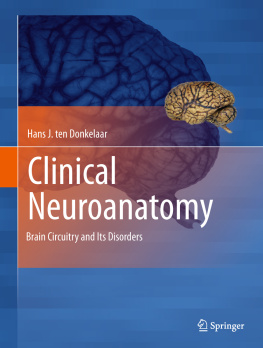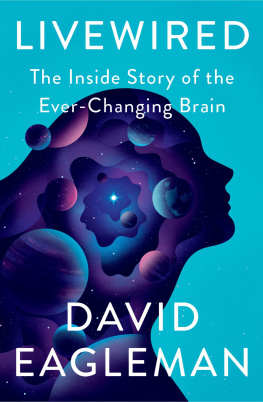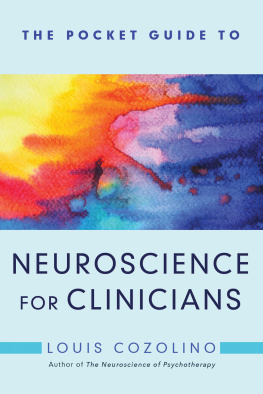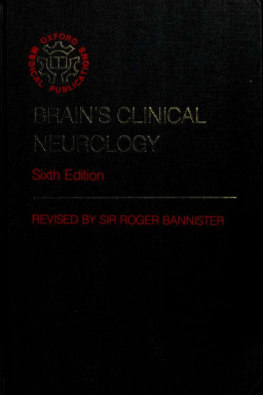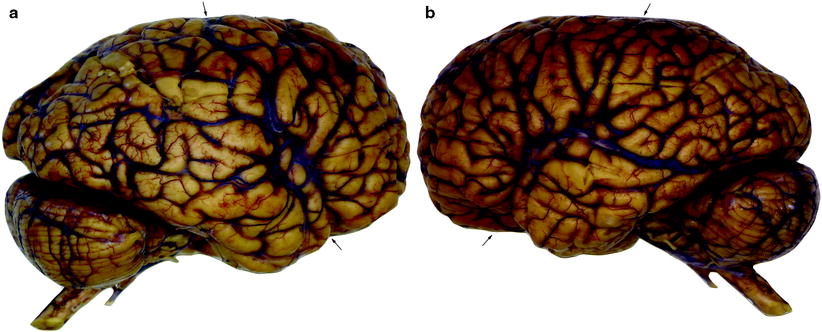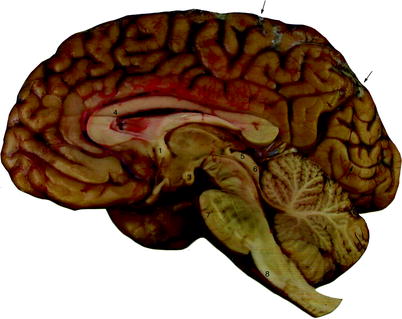1.1 Introduction
In this introductory chapter, an overview will be presented of the macroscopy and microscopy of the central nervous system (CNS). More in particular, the various structures of the brain and the spinal cord and their main fibre connections will be discussed. The vascularization of the brain and the spinal cord will be discussed in Chap. 2.
1.2 Macroscopy of the Brain
The lateral aspect of the brain is dominated by the cerebrum but also parts of the cerebellum and the brain stem are visible. On the medial aspect of the hemisected brain, the diencephalon becomes visible. The basal aspect of the brain lies on the base of the skull and is formed by the basal parts of the cerebrum, the brain stem and the cerebellum. The cerebrum consists of two cerebral hemispheres, each of which is composed of frontal, parietal, occipital and temporal lobes. The two hemispheres are separated by the interhemispheric fissure. Lateral, medial, dorsal and basal views of the brain will be discussed.
1.2.1 Lateral View of the Brain
On the lateral aspect of the cerebrum (Fig. ).
Fig. 1.1
Lateral views of the right ( a ) and left ( b ) hemispheres, still enveloped by the leptomeninges. Note the difference between the slope of the lateral sulcus (indicated by lower arrow ). The upper arrow indicates the central sulcus (courtesy Pieter Wesseling and Arie Maat, Nijmegen)
In the frontal lobe , superior , middle and inferior frontal gyri , separated by superior and inferior frontal sulci, and the precentral gyrus are found (Fig. ; see Chap. 15).
The temporal lobe is composed of the superior , middle and inferior temporal gyri , separated by the superior and inferior temporal sulci (Fig. ; see Chap. 15). The triangular insula of Reil, described by Johann Christian Reil in 1809, lies in the depths of the lateral sulcus and is covered by the frontal, frontoparietal and temporal opercula. Its concave lower side is known as the limen insulae . The insula contains several vertically directed gyri, the gyri breves and longi .
On the lateral aspect of the parietal lobe , the postcentral gyrus , and the superior and inferior parietal lobules , separated by the intraparietal sulcus, are present. The inferior parietal lobule consists of the supramarginal and angular gyri (Fig..
1.2.2 Medial View of the Brain
The prominent sulcus on the medial aspect of the cerebrum is the cingulate sulcus (the sulcus cinguli or scissure limbique of Broca ). Caudal to the paracentral lobule lies the large precuneus . The inner zone is formed by the cingulate gyrus , which is continuous through a narrowing (the isthmus gyri cinguli ) with the parahippocampal gyrus in the temporal lobe. The posterior part of the medial cerebral cortex has two deep sulci, which converge towards the splenium. The parieto - occipital sulcus separates the parietal and occipital lobes, and the calcarine sulcus divides the occipital lobe into a dorsal part (the cuneus ) and a ventral part (the lingual gyrus ). The primary visual cortex is mainly found above and below the calcarine sulcus.
Fig. 1.2
Medial view of the right hemisphere after removal of the leptomeninges. The arrows indicate the central sulcus at the left and the parieto-occipital sulcus at the right. Indicated by numbers are: (1) anterior commissure; (2) posterior commissure; (3) mammillary body; (4) corpus callosum; (5) colliculus superior; (6) colliculus inferior; (7) pons; (8) pyramis (courtesy Pieter Wesseling and Arie Maat, Nijmegen)
In the midsagittally cut brain, the most prominent structure is the corpus callosum (Fig. ). Different parts of this structure are referred to as the rostrum , the genu , the truncus and the splenium . The most rostral part is the rostrum, which borders on the lamina terminalis. The truncus is the middle part, whereas the splenium forms the thick caudal part. Below the corpus callosum, the septum pellucidum and the fornix are found. The third ventricle shows three recesses, the infundibular recess into the upper part of the hypophysial stalk, the optic recess above the optic chiasm, and the pineal recess below the pineal gland (the epiphysis cerebri ). The third ventricle continues caudally via the aqueductus cerebri of the mesencephalon into the fourth ventricle . Above the cerebral aqueduct, the superior and inferior colliculi are found and, dorsal to the fourth ventricle, the cerebellum . The fourth ventricle intrudes into the cerebellum as the fastigium . Between the inferior colliculus and the cerebellum, the roof of the fourth ventricle is formed by a thin membrane, the velum medullare superius on which lies the lingula of the cerebellum. The caudal part of the roof of the fourth ventricle is formed by the tela choroidea and the plexus choroideus.
1.2.3 Dorsal View of the Brain
In the brain, viewed from above, the frontal, parietal and occipital lobes are visible (Fig. ). The cerebral hemispheres are separated by the longitudinal interhemispheric fissure . In the frontal and occipital regions, the separation is complete but centrally the fissure extends only to the broad interhemispheric commissure, the corpus callosum. Almost halfway between the frontal and occipital poles of each hemisphere, the central sulcus courses from the medial margin of the dorsal surface of the brain towards the lateral sulcus. Parallel to this sulcus are located the precentral gyrus rostrally and the postcentral gyrus caudally. These gyri are bordered by the precentral and postcentral sulci, respectively. In front of the precentral gyrus are, from medial to lateral, the superior frontal gyrus, the superior frontal sulcus, the middle frontal gyrus, the inferior frontal sulcus and the inferior frontal gyrus. Caudal to the postcentral sulcus can be distinguished the superior and inferior parietal lobules, the parieto-occipital sulcus and the occipital gyri.

